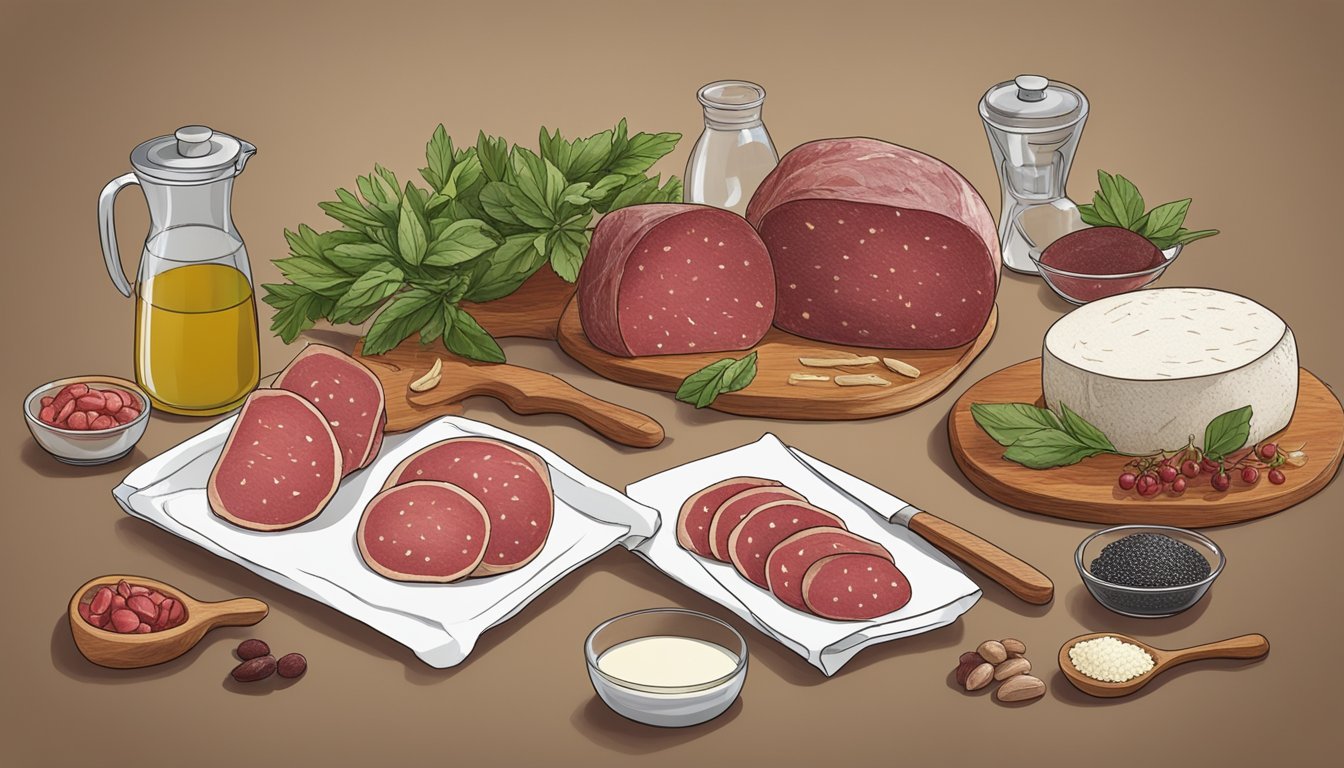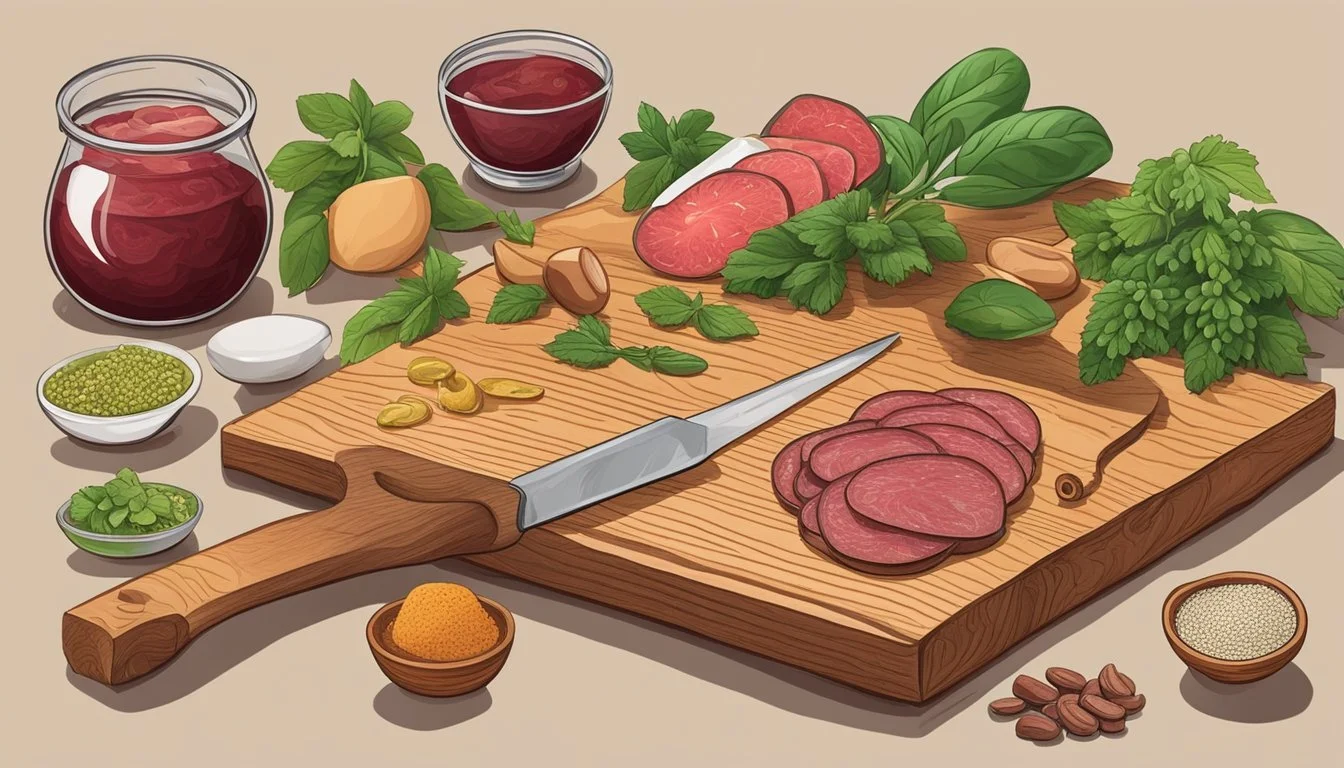Bresaola Making Made Easy
Your Guide to Crafting the Perfect Charcuterie
Bresaola, a delicacy originating from the Valtellina region in Italy, is prized for its rich, savory flavors and delicate texture. Unlike most cured meats that are made from pork, bresaola is crafted from beef, specifically the eye of round cut, a lean piece that makes it uniquely succulent when cured. The curing process involves a harmonious blend of salt and seasonings that imbues the beef with its characteristic taste, a combination of white pepper, nutmeg, and a selection of warm spices.
Making bresaola at home might seem intimidating at first, but it is a straightforward process that rewards patience and precision. The trimmed beef is massaged with the spice blend, then allowed to cure in a controlled environment, which can be as accessible as a home refrigerator. Home curing allows for customization of flavors and the satisfaction of creating an artisanal product with all-natural ingredients.
Timing and attention to detail are crucial in achieving the perfect bresaola. Throughout the curing phase, turning the meat regularly ensures an even distribution of flavors and proper dehydration. The aging process that follows is where the magic happens, with air circulation contributing to the concentration of flavor and the creation of bresaola's signature texture. With careful observation and adherence to guidelines, even novices can produce bresaola that embodies the essence of this Italian charcuterie (What wine goes well with charcuterie?) tradition.
The Origins and Basics of Bresaola
Bresaola is a testament to the time-honored traditions of Italian charcuterie. Originating from the Valtellina valley in the Lombardy region of northern Italy, this cured meat delicacy is cherished for its rich flavor and tender texture.
Identification: Bresaola is easily recognizable by its deep red color and round or oval shape. It is distinctly Italian, a fine example of charcuterie that focuses on the air-drying process.
Preparation: The process begins with eye of round beef, a cut prized for its lean quality. Butchers expertly trim the meat, prepping it for a dry rub of salt and a carefully chosen mix of spices like white pepper and nutmeg. This blend not only seasons the meat but kickstarts the curing phase.
Curing Process:
Meat is generously coated with the spice blend.
Excess spices are reserved for later use.
Meat is placed in a non-reactive container and refrigerated.
Aging: Following the initial cure, which typically lasts around 12 days with a daily turn of the meat, bresaola undergoes a meticulous air-drying phase. This step is crucial to developing its characteristic texture and concentrated flavor.
Bresaola stands out in the world of Italian cured meats for its simplicity and elegance, often served thinly sliced with a drizzle of olive oil, a squeeze of lemon, or a shaving of Parmigiano-Reggiano, showcasing its unadulterated flavor. It is the epitome of Italian culinary craftsmanship, a lean, air-dried meat that captures the essence of Italy's charcuterie expertise.
Selecting the Right Meat
When crafting bresaola, the selection of meat is a pivotal decision that influences the final product's quality. The ideal cut is lean, with minimal connective tissue, to ensure even curing and optimal texture.
Beef Selection
The cut of beef commonly used for bresaola is the eye of round, a subsection of the top round. This muscle is located in the hindquarters of the animal and is known for its leanness. Eye of round should be chosen for its fine grain and lack of fat. The meat should be uniformly trimmed, which is essential for the curing process.
Meat Quality
The quality of meat is non-negotiable. One must look for lean beef with a deep red color, signifying freshness and optimal pH balance. The meat should have very little to no marbling, as excess fat can impede the curing process and affect the texture of bresaola. A key step is to source beef from reputable butchers or suppliers who uphold high standards for quality.
Ingredients and Equipment
When making Bresaola, precision in the use of spices and curing agents is key. The correct equipment streamlines the process and ensures safety and quality in the finished product.
Essential Spices
A harmonious blend of spices is crucial for flavoring Bresaola. Common spices include:
Salt: Acts as a base for curing and is essential in the spice blend.
Black pepper: Adds a sharp, piquant flavor.
Juniper berries: Provide a piney, slightly fruity note.
Rosemary: Its aromatic, woodsy essence complements the beef.
Sage: Offers a slightly peppery taste.
These spices should be freshly ground using a spice grinder or a mortar and pestle for maximum flavor release.
Curing Agents
Curing agents preserve the meat and enhance its taste. The primary agents include:
Salt: A key agent for dehydration and preservation.
Curing salt: Contains nitrates, which safeguard against bacteria and contribute to the meat's pinkish color.
The curing process should be done in controlled amounts, respecting safety guidelines to prevent the growth of harmful bacteria.
Tools Needed
A well-equipped kitchen simplifies the Bresaola-making process. The required tools are:
Butcher's knife: For trimming meat to the desired shape.
Kitchen scale: For precise measurement of spices and curing agents.
Non-reactive container: Such as stainless steel or food-safe plastic, to hold the meat during curing.
Refrigerator: Set at a controlled temperature for the curing stage.
Vacuum sealer (optional): Seals the meat with spices for an even cure.
The equipment ensures that preparation is hygienic and that the Bresaola cures properly.
Preparation and Curing Process
The success of making Bresaola hinges on meticulous beef preparation, precise curing mix application, and carefully monitored curing stages. Each step is critical in achieving the distinctive flavor and texture of this cured meat.
Trimming the Beef
One should begin with a lean cut of beef, such as the eye of round. It's imperative to trim away all excess fat and silverskin to allow the curing agents to penetrate uniformly. The aim is to achieve a clean, uniform cut which promotes even curing.
Applying the Cure
The cure is a combination of kosher salt, sugars, and an array of spices like cloves and nutmeg. One can also incorporate curing salts for additional safety. The cure mixture should be massaged thoroughly into the meat ensuring full coverage. A dry cure method directly applies these ingredients to the surface of the beef.
Cure Recipe:
3% of the meat's weight in kosher salt
0.25% of the meat's weight in curing salt (optional for color and preservation)
1% of the meat's weight in sugar
Spices (to taste, typically including cloves, nutmeg, and black pepper)
Instructions:
Mix the salts, sugar, and spices in a bowl.
Massage the mixture into the beef, covering all sides.
Curing Stages
Initially, the coated beef is placed in a non-reactive container or a vacuum-sealed bag to rest in the refrigerator. The ideal temperature is between 34°F and 38°F (1°C to 3°C) with the meat being turned once daily. This stage lasts for approximately 2-4 weeks, with the meat losing up to 20-30% of its original weight, signaling completion. Humidity control is not crucial at this stage, as the refrigerator environment typically suffices.
Curing Time:
Thickness (cm) Minimum Curing Time (days) 5 7.5 10 15
After the initial curing time, the beef should be rinsed to remove any excess salt and then patted dry. Some recipes call for a brief soak in a vinegar solution to neutralize the surface, followed by another drying period to prepare for the aging process.
Aging and Drying
Aging and drying are crucial stages in the Bresaola making process, where the flavor develops and the texture transforms. Proper execution of these steps ensures a successful end product with the desired concentrated taste and tender structure.
Setting Up the Curing Chamber
To begin the aging and drying phase, one must first establish the curing chamber. This controlled environment is pivotal for the transformation of the seasoned beef into Bresaola.
Temperature: The chamber should be maintained at a cool 55°F (13°C), characteristic of Lombardy's cellars where Bresaola originates.
Humidity: A critical aspect to monitor is the humidity level, which must be kept around 80%. This specific humidity is essential for the meat to air-dry correctly, without drying out too quickly or becoming overly moist, which could spoil the meat.
Here's a step-by-step guide to prepare the chamber:
Choose a space that can maintain a consistent temperature and humidity, such as a wine fridge or a specially designed curing fridge.
Equip the space with a reliable thermometer and hygrometer to monitor conditions closely.
Ensure the space is well-ventilated to encourage even drying.
Line the chamber with food-safe shelves or racks that allow air to circulate around the meat.
Monitoring Conditions
Patience is essential as Bresaola takes time to develop its color and texture during the aging process. Frequent checks are critical:
Regularly examine the Bresaola for any changes in color and texture, looking for a deep red hue and a firm feel.
Use twine or similar methods to hang the meat. If using muslin or cheesecloth, ensure it is wrapped securely and allows the meat to breathe and moisture to escape.
An accurate log should be maintained, noting:
Date Temperature Humidity Level Observations YYYY/MM/DD 55°F 80% No changes observed
In summary, the aging and drying process for Bresaola involves consistent monitoring and precise conditions within the curing chamber to achieve the traditional Lombardy air-dried delicacy.
Finishing Touches and Quality Control
Once the bresaola has completed the curing and drying process, it's crucial to perform a thorough inspection to ensure the quality of the meat. This final stage embodies the transition of the lean beef into a delicacy ready to rival the offerings of a traditional Italian deli.
Inspection and Taste Test
Initial Inspection: The first step is to visually inspect the bresaola for any signs of spoilage or uneven drying. One should look for a uniform color without any dark or overly dry spots. The texture should be firm but not hard.
Smell: Next, the olfactory inspection begins. The bresaola should have a pleasant, slightly tart smell, absent of any off or unexpected odors.
Taste Test: A small piece can be sliced and tasted. The flavor should be rich and savory with the spices used during the curing process, evoking the classic taste of Italian cured meats. The texture needs to be checked as well; it should be tender and melt on the tongue, without any toughness.
Slicing and Presentation
Thin Slices: To serve, traditional bresaola is cut into ultra-thin slices, which can be achieved with a sharp knife or a deli slicer. The thinness of the slice is important as it influences both the texture and the taste, allowing the bresaola's flavors to be fully appreciated.
Presentation Tips: For presentation, lay each slice out flat on a platter without overlapping. They can be served with a drizzle of olive oil and lemon juice, complementing the lean and aromatic qualities of the meat. Use a kitchen towel to gently blot any excess oil to ensure a neat appearance.
By adhering to these steps, one ensures that the bresaola is not only safe to enjoy but also presented in a way that pays homage to the artisanal traditions from which this delicacy originates.
Serving and Pairing Suggestions
Bresaola, with its rich flavor and delicate texture, complements a variety of ingredients and can transform simple dishes into gourmet experiences. Below are some pairing suggestions that celebrate both traditional Italian flavors and innovative culinary ideas.
Traditional Italian Pairings
In the realm of classic Italian cuisine, bresaola is often enjoyed as an antipasti. The following pairings are quintessential:
Arugula Salad: Top fresh arugula leaves with thin slices of bresaola, shaved parmesan, a sprinkle of lemon zest, and a drizzle of olive oil. A dash of balsamic vinegar completes this starter.
Pasta: Enhance a simple pasta dish by incorporating bresaola into it. After cooking your favorite pasta, toss it in olive oil, garlic, and lemon, and top with bresaola strips for a light yet satisfying meal.
Prosciutto Substitute: Bresaola can be used in place of prosciutto in many dishes, adding a unique, less fatty flavor to traditional recipes such as melon with cured meats or wrapped around grissini breadsticks.
Innovative Serving Ideas
Beyond the traditional pairings, bresaola's versatility shines through in various creative serving suggestions:
Appetizer Plates: Create a modern twist on the classic appetizer plate by incorporating bresaola with a selection of cheeses, fruit compotes, and artisanal bread. Its delicate gamey notes pair beautifully with bold flavors.
Sandwiches: For a hearty yet sophisticated sandwich, layer slices of bresaola with sun-dried tomatoes, arugula, and a spread of goat cheese on ciabatta bread.
By carefully considering the interplay of flavors and textures, one can elevate the bresaola experience with these traditional and innovative pairings. Bresaola's versatility makes it ideal for both delicate salads and robust sandwiches, ensuring there's a combination to satisfy every palate.
Storing and Preservation
Once the bresaola has been properly cured, ensuring its longevity and taste is paramount. Preservation hinges on maintaining the optimal environment where temperature and humidity are controlled.
Refrigeration is the most accessible method for many. Bresaola should be stored in the fridge, ideally at temperatures between 10 to 14 degrees Celsius. This cold environment slows down spoilage effectively. It is advisable to wrap the bresaola in a clean dishtowel before placing it in the refrigerator, which helps to absorb any excess moisture and prevents spoilage.
To maintain the necessary humidity, 70-80% relative humidity (RH) is recommended for storing bresaola. If one's fridge tends to be drier, placing a container of water inside can help regulate moisture levels. However, one must ensure the bresaola does not come into contact with the water directly as this could hasten spoilage.
In cases where a piece of bresaola needs to be air-dried further for enhanced flavor and texture, it can be hung in a curing chamber or a cellar, both of which should mimic the required humidity and temperature conditions.
Here's a simple table summarizing the conditions for storage:
Environment Temperature Humidity Notes Refrigerator 10-14°C Fridge-specific RH; can use a water container Wrap in dishtowel, cover in food wrap if sliced Curing Chamber 12-14°C 70-80% RH Ideal for air-drying and enhancing flavors Cellar 10-14°C 70-80% RH Natural option if available, mimic fridge settings
In third-person perspective, they must understand that bresaola is a delicate, lean preserved meat that requires careful storage. The key to successful preservation is managing a cold environment with just the right level of humidity. Following these guidelines, they can enjoy bresaola at its best for an extended period.
Troubleshooting Common Issues
When crafting Bresaola, weight loss is expected and necessary during the drying process. However, if the meat loses weight too rapidly, it may dry unevenly, resulting in a tough texture. To prevent this, ensure the piece of meat is not placed in an area with excessive airflow.
Humidity plays a critical role in the curing process. If the environment is too humid, the piece risks spoilage due to bacterial growth. Conversely, low humidity may cause the outside to harden too quickly, trapping moisture inside. The ideal relative humidity level should be between 60% and 80%.
Maintaining the correct temperature is essential for safety and quality of the final product. Temperatures too high can foster harmful bacteria, while temperatures too low can hinder proper curing. A stable temperature range between 50-60°F (10-15°C) is recommended.
To avoid spoilage, one must ensure cleanliness throughout the preparation process and use curing salts that inhibit bacteria growth. Any mold on the surface should be addressed immediately. White mold is typically benign, while green or black mold indicates spoilage.
The desired red color in Bresaola is a sign of proper curing. Insufficient curing time, incorrect ratios of curing salt, or inadequate spice penetration can cause inconsistencies in color.
Below is a quick reference table for common issues and suggested actions:
Issue Possible Cause Suggested Action Rapid weight loss Excess airflow Relocate to less drafty area High humidity Poor air circulation Improve airflow, dehumidify Low humidity Dry environment Use a humidifier, check seal of curing chamber Spoilage Contamination Ensure cleanliness, use correct amount of curing salt Inconsistent color Curing process Verify spice mixture, ensure proper curing time
By adhering to these principles, one can mitigate many of the common issues that arise during the Bresaola making process.
Health Considerations and Nutrition
When embarking on the preparation of Bresaola, understanding the health implications and nutritional content is essential. Bresaola is a lean source of protein, as it is typically made from the eye of round, a cut of beef with minimal fat. This makes it a healthier choice compared to other types of cured meats that may have higher fat content.
The curing process, however, involves substantial amounts of salt, which serves to both flavor the meat and prevent bacterial growth. While the use of salt is critical for safety and taste, it is also important to be mindful of sodium intake, particularly for individuals with hypertension or heart conditions.
Cured meats, including Bresaola, also contain varying levels of nitrates and nitrites, which are commonly used in curing for their preservative qualities. Some studies suggest a correlation between the consumption of cured meats and certain health risks, though moderate intake can be part of a balanced diet.
Below is a nutritional overview of Bresaola per 2-ounce (56-grams) serving:
Calories: 80
Protein: 14g
Fat: 2g
Sodium: 700mg (approximately, can vary)
Cholesterol: 40mg
It is also a source of:
Vitamin B12
Iron
Zinc
Eating Bresaola in moderation is key, and it can be a valuable protein addition to various diets, provided that one pays attention to serving size and overall sodium consumption. Choosing to pair Bresaola with other nutrient-dense foods such as vegetables can help balance the meal.
People with dietary restrictions or health concerns should consult with a healthcare provider to determine how Bresaola fits into their personal health plan.
Bresaola Beyond the Basics
Expanding on the tradition of making Bresaola, there are advanced techniques and variations available that offer a more intricate approach to this Italian delicacy. The subsections below explore these refinements and suggest ways to integrate creativity into your recipes.
Advanced Techniques and Variations
In the realm of curing meat, seasoned artisans often incorporate a range of spices and herbs such as rosemary, juniper, and black pepper to elevate the flavor profile of Bresaola. A precise application of these spices can transform the simple cured beef into a rich, nuanced experience. Let's look at some specific techniques:
Spiced Curing Mix:
Combine equal parts of ground juniper berries and black pepper with half the amount of rosemary.
Apply the mix thoroughly to the beef for a refreshing, aromatic twist on the classic Bresaola cure.
Aromatics in the Curing Stage:
Add whole sprigs of rosemary and juniper branches to the salt cure, allowing their flavors to infuse gradually.
Controlled Humidity and Aging:
Adjust the humidity and temperature of the aging environment to refine the texture and taste, experimenting with longer aging times to intensify the complexity.
Creative Recipes
Innovative recipes integrate Bresaola with unique flavor combinations, presenting it as more than just an appetizer. Incorporating Bresaola into varied dishes allows it to shine alongside other ingredients:
Bresaola-wrapped Asparagus:
Thinly slice Bresaola and wrap it around blanched asparagus spears, drizzling with a balsamic vinegar reduction for an elegant side dish.
Bresaola Salad with Italian Flair:
Toss mixed salad greens with slivers of Bresaola, shave horse bone marrow generously over the top, and finish with a vinaigrette made with Italian vinegar.
These elevated techniques and recipes offer rich flavors and textures, ensuring Bresaola's place both on the charcuterie board and in main courses.
Connecting with the Bresaola Community
Engaging with the Bresaola community provides valuable insights into the art of curing meat and can enhance one's skill and knowledge. Individuals can access a wealth of information through online platforms and by conversing with local experts.
Online Forums and Resources
Online forums are a treasure trove of information where enthusiasts can discuss techniques and troubleshoot the curing process. Websites such as Pinterest offer a plethora of Bresaola recipes and visuals that can assist in understanding the procedure better. Additionally, instructional videos — often shared by experienced curers from Italy, the birthplace of Bresaola — can visually guide newcomers through each step of the meat curing process.
Beneficial online resources:
Recipe sharing platforms: Search for Bresaola specific boards
Instructional videos: Look for how-to guides or tutorials
Social media groups: Join Bresaola and meat curing communities
Local Butcher and Charcuterie Shops
One's local butcher can be an invaluable resource when it comes to meat curing. Many butchers, especially those specializing in Italian charcuterie, are often well-versed in the art of curing Bresaola and usually willing to share tips and advice. Some shops might even offer classes or demonstrations. Patrons should not hesitate to ask questions and seek guidance from these seasoned professionals.
Ways to connect locally:
Ask questions: Inquire about cuts and curing techniques
Attend workshops: Participate in any available Bresaola-making classes
Purchase supplies: Support local businesses by buying high-quality cuts and spices from them
Legal and Safety Regulations
When making Bresaola at home, it is imperative to adhere to certain legal and safety regulations to ensure a safe and quality product. Here's a concise overview:
Curing Salt: The use of curing salts containing sodium nitrite is crucial in preventing the growth of harmful bacteria. It's mandatory to follow manufacturer guidelines regarding the quantity and the mixing procedure.
Refrigerator: Temperature control is paramount during the curing process. The refrigerator must maintain a consistent temperature, typically between 34°F to 38°F, to prevent spoilage and ensure proper curing.
Key Points for Compliance and Safety:
Regulation and Approval:
In commercial settings, production and sales require regulatory approval.
For home production, check local food safety guidelines.
Handling and Usage of Ingredients:
Wear gloves when handling raw meat.
Use only food-grade containers for curing.
Ingredient Safety Measure Curing Salt Measure precisely; do not exceed recommended amount. Refrigerator Regularly monitor temperature.
Hygiene and Sanitation:
Maintain a clean workspace and sanitize tools.
Regularly wash hands and avoid cross-contamination.
Curing Process:
Cure the meat for an appropriate duration based on size and weight.
Turn the meat periodically to ensure an even cure.
Final Inspection:
Before consuming, inspect the Bresaola for any off-odors, discoloration, or unusual texture, which could indicate spoilage. One should discard any product that doesn't meet safety standards.
History and Cultural Significance
In the heart of the Lombardy region of Italy, bresaola stands as a testament to a time-honored tradition in charcuterie. Originating from Valtellina, a valley in the Alps of northern Italy, this air-dried beef has been a culinary staple for centuries. Unlike prosciutto, which is made from pork, bresaola is crafted from beef, highlighting the versatility of Italian charcuterie.
Historically, families in Valtellina would cure their own bresaola, each adhering to secret recipes passed down through generations. This custom persisted until the 19th century when food production advancements in Chiavenna allowed for commercial distribution, thereby increasing bresaola's popularity beyond local households.
The methods used to create bresaola date back to the early Middle Ages. They involve salting and air-drying the meat, a process that was not only applied to beef but also extended to sheep and game meats. This preservation technique was crucial for the Alpine community, allowing them to store food throughout harsh winters.
Today, Bresaola della Valtellina has earned the IGP (Indicazione Geografica Protetta) status, which recognizes its unique connection to the geographical region. Bresaola's significance transcends mere sustenance, capturing the essence of Lombardy's gastronomic heritage and its cultural identity within Italy.
The Future of Bresaola Making
The art of crafting Bresaola is witnessing a variety of futuristic trends and innovations that reflect the evolving tastes and techniques within the culinary world. As enthusiasts and professionals alike seek to perfect this delicacy, the future points towards a blend of tradition and cutting-edge technology in the kitchen.
Equipment advancement plays a pivotal role in shaping Bresaola making's future. Cutting-edge tools are becoming increasingly accessible, allowing for more precise control over the curing environment. Smart curing chambers incorporate sensors and automated systems that precisely regulate humidity and temperature, yielding consistent and superior results.
In terms of a trend, there's a marked shift towards sustainability and sourcing locally. Consumers' growing interest in the origins of their food has led to a preference for locally sourced, organic beef. This farm-to-table approach supports local economies and promises fresher ingredients for Bresaola making.
Bresaola makers are also embracing innovation in the form of non-traditional flavors. While classic spices like salt, pepper, and nutmeg remain staples, there is an openness to experimenting with exotic herbs and spices, catering to a global palate and adding unique twists to the traditional flavor profile.
Lastly, the kitchen setup for Bresaola making is becoming more modular and adaptable. Users have an array of options from professional grade equipment to compact units designed for home enthusiasts, enabling anyone to try their hand at making Bresaola regardless of space constraints.
These are exciting times for aficionados of Bresaola, as the melding of authenticity and innovation paves the way for more creative and refined curing processes, broadening the horizons for homemade and artisanal charcuterie.













